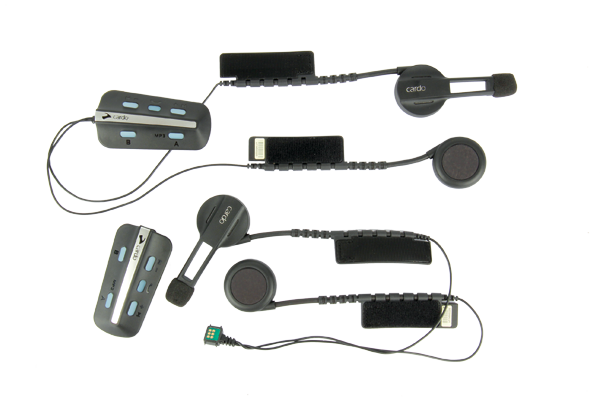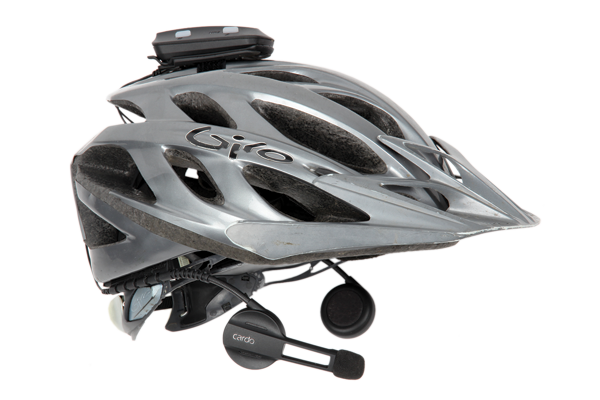Cardo BK1 Bluetooth
 At first I dismissed this product but was told, “Give it a try and see what I think.” Fair enough! Three years ago I didn’t see the point of a ‘smart phone’, now I damn near sleep with one, so who’s to say I don’t ‘need’ one of these!
At first I dismissed this product but was told, “Give it a try and see what I think.” Fair enough! Three years ago I didn’t see the point of a ‘smart phone’, now I damn near sleep with one, so who’s to say I don’t ‘need’ one of these!
Cardo has a background in making communication devices for motorbike riders. Their hands-free Bluetooth headsets allow full-face clad riders to chat whilst blasting along the highway at 100kph—there’s a clear need in that market, as you’d have no hope of communicating without something like the Cardo.
Their new BK1 uses the same technology but in a cycling-friendly package. Each device consists of a main control unit that straps to your helmet, plus two speakers and a microphone. The speakers mount to your helmet with adhesive velcro patches and their ‘adjustable booms’ allow you position them appropriately—they are designed to hover over your ears but not touch them. We tried a number of different helmets and had no issues in getting the BK1 to fit. The control unit contains a built-in rechargeable battery and the entire system weighs a fairly minimal 118g.
So what does it do and how did it perform? It connects with any Bluetooth phone, allowing you to make and receive calls. Likewise, Bluetooth MP3 (and phones) can be linked so that you can listen to your tunes whilst on the trail. Finally, if you’ve got a riding buddy with a Cardo, you can pair the units and chat whilst on the trail. Up to three units can be paired for group conversations.
It’s worth spending a bit of time reading the instructions and playing with the BK1 before heading out on a ride—there’s a fair bit to this device and it may take a while before you learn to use all of the features.

For unit-to-unit conversation, Cardo claims a straight line range of 500m, but that’s only in optimal conditions. On the trail it was more like 100-200 meters on a fire trail and 50-100 meters in the singletrack—it really depended on how dense the surrounding forest was. Don’t expect long distance communication, and if your riding partner takes a wrong turn, you’ll still need to be fairly close to alert them.
On casual fire trail rides and when riding within earshot of my ride partner, I didn’t find the Cardo helpful. In this situation you’d still hear their voice, but also hear them through the Cardo with a slight delay. After a while this feedback became pretty irritating.
Most of the time you can hold a normal conversation when riding side-by-side or when following each other closely, at least at normal trail-riding speeds anyway. Beyond this, the Cardo comes into its element. When descending or riding a few bike-lengths apart, there’s no need to raise your voice—just talk normally and your buddy will hear you as if you were right there. You can chat away when railing the singletrack and warn of a trail obstacle whilst out of sight. You’ll hear your mate have a near miss or yelp for joy—it definitely heightens the level of interaction on more technical and demanding trails. Be warned though, the audio clarity is very good, so you’re likely to hear things that you don’t want to; ‘nature breaks’ and belching immediately come to mind!
While I found the rider-to-rider intercom wasn’t universally helpful, the Bluetooth MP-3 compatibility was great. I used to like listening to music when out on a long lonely trail ride but using standard ear buds has always been a pain. They hurt your ears after a while or just fall out, plus the wires get in the way and snag on passing foliage. With the Cardo fitted, you keep your phone or MP3 device safely in your pocket or pack. The volume and track selection can be controlled via the BK1 and there are no wires attached, so removing your helmet doesn’t leave you tangled or hooked up. Best of all, the speakers offer great sound whilst still allowing more ambient sound filter through than your typical ear-bud style headphones. Obviously it still reduces your perception of surrounding sounds, but as long as the volume is down, you’ll still hear the birds tweeting and the crunch of dirt under your tyres. Roadies take note, as it’s a far safer proposition if you want to listen to music whilst pounding the blacktop.
The phone interconnectivity was also surprisingly handy. You’ll hear a call come in through the headphones as it overrides your music or conversation. Stay quiet and the incoming call will be ignored, say something and you’ll take the call. Again the sound quality is excellent and the other person won’t know that you’re actually whizzing down the trail. If your phone has some form of voice activation, you’ll also be able to make calls while you ride.
At first the thought of making and receiving calls while riding sounded philosophically wrong (and maybe it is) however it does come in handy. All of the ‘where the hell are you’ and ‘honey I’m running late’ calls can be tackled without interrupting the flow of a ride—weird but true and it’s funny how quickly you get used to it and take these functions for granted.
With its noise cancellation and multiple device connectivity, this little gismo incorporates lots of high-tech features and it certainly worked well. The biggest hurdle is likely to be its price tag; at $300 per unit or $550 for a twin kit (to share with a mate), it’s a very pricy prospect. Still, with people lining up around the block to drop hundreds of dollars on the latest i-gadget, you never know…
Cassons (02) 8882 1900 / www.cardosystems.com





